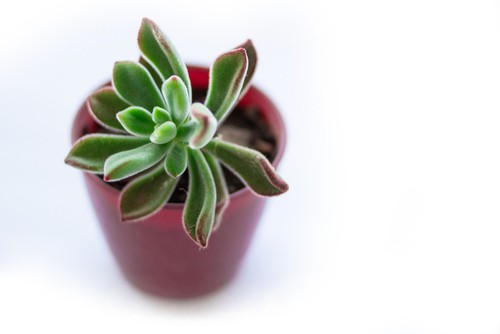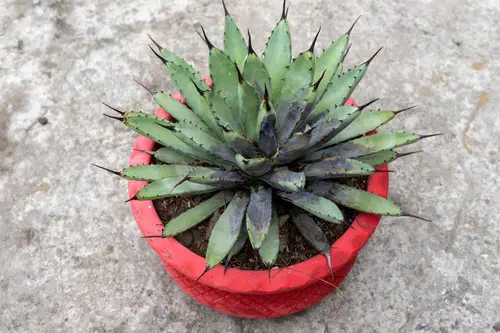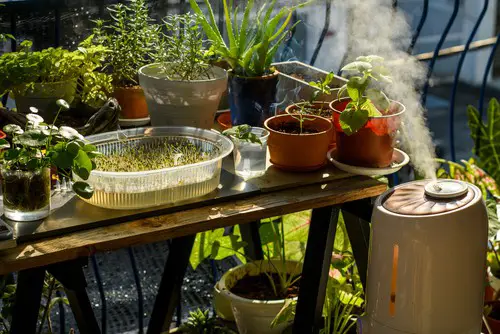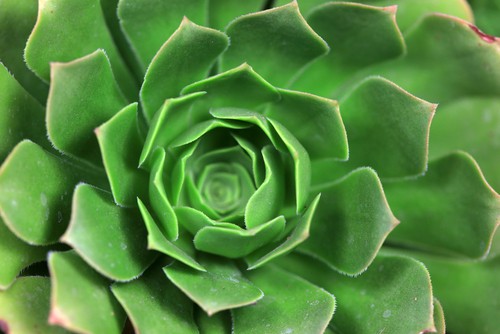Tiny black spots on succulent leaves can be a sign of a problem that needs attention. Succulents are known for their hardiness and ability to withstand various environmental conditions, but they are not immune to diseases and pests.
These tiny black spots can indicate a range of issues, from sunburn to fungal infections, and it’s important to identify the cause and take appropriate action to save the plant.
Identifying the cause of the black spots is crucial in determining the appropriate treatment. Some common causes of black spots on succulent leaves include overwatering, sunburn, frost damage, pests, and fungal infections.
Overwatering is a common problem with succulents, and it can lead to root rot and the growth of fungi that cause black spots on the leaves. Sunburn can also cause black spots, especially if the plant is exposed to direct sunlight for extended periods.
Pests such as mealybugs and aphids can also leave tiny black marks on the leaves, and fungal infections can cause black spots that spread rapidly if left untreated.
In order to prevent black spots on succulent leaves, it’s important to provide the right growing conditions for the plant. This includes proper watering, appropriate lighting, and good air circulation.
Regularly inspecting the plant for signs of pests or disease can also help prevent the spread of black spots. If black spots do appear, early intervention is key to preventing further damage to the plant.
Treatment options may include removing affected leaves, adjusting watering habits, or applying fungicides or insecticides. By taking the appropriate steps, succulent owners can help their plants thrive and avoid the unsightly appearance of tiny black spots on their leaves.
Key Takeaways
- Identifying the cause of black spots on succulent leaves is crucial in determining the appropriate treatment.
- Preventing black spots on succulent leaves involves providing the right growing conditions and regularly inspecting the plant for signs of pests or disease.
- Early intervention is key to preventing further damage to the plant, and treatment options may include removing affected leaves, adjusting watering habits, or applying fungicides or insecticides.
Also don’t miss:
Identifying Tiny Black Spots on Succulent Leaves

Tiny black spots on succulent leaves can be a sign of a variety of problems. These spots can be caused by pests, fungus, sunburn, or overwatering. It is important to identify the cause of the black spots in order to properly treat the issue.
If the black spots are caused by pests, such as mealybugs or aphids, they will appear as tiny black dots on the leaves. These pests feed on the succulent and leave behind dark marks.
If the black spots are caused by fungus or overwatering, they will appear as larger black spots on the leaves. These spots may also be accompanied by yellowing or softening of the leaves.
If the black spots are caused by sunburn, they will appear as dry black spots on the leaves. This can happen when a succulent is placed in strong sunlight before it has had time to acclimate to it. It is important to gradually increase the amount of sunlight a succulent receives to prevent sunburn.
To properly identify the cause of the black spots, it is important to inspect the leaves and the soil. If the soil is wet and the leaves are soft, the black spots may be caused by overwatering.
If the soil is dry and the leaves are dry and brittle, the black spots may be caused by sunburn. If there are tiny black dots on the leaves, the black spots may be caused by pests.
Tiny Black Spots on Succulent Leaves – 6 Common Problems
Succulents are known for their hardiness and easy maintenance, but they are not immune to problems. One of the most common problems that succulent owners encounter is the appearance of black spots on the leaves.
There can be several reasons for this, and it’s important to identify the cause so that you can take appropriate action to save your plant.
1. Over-Watering
Over-watering is one of the most common causes of black spots on succulent leaves. When succulents are over-watered, they can develop water warts, fungus, and rot. This can cause the leaves to turn black and mushy.
To avoid over-watering, make sure that the soil is completely dry before watering again. Succulents can survive without water for a long time, so it’s better to err on the side of caution and water less frequently.
2. Sunburn
Sunburn is another common cause of black spots on succulent leaves. When succulents are exposed to too much direct sunlight, their leaves can become damaged and turn black.
To avoid sunburn, make sure that your succulents are not exposed to direct sunlight for more than a few hours a day. You can also move them to a shadier spot or provide them with some shade cloth.
3. Pests and Insects

Pests and insects can also cause black spots on succulent leaves. Mealybugs, aphids, ants, and other pests feed on succulents and can leave dark marks on the leaves. To get rid of pests, you can use insecticides or pesticides. You can also try wiping the leaves with a damp cloth to remove any pests that may be present.
4. Fungal and Viral Infections
Fungal and viral infections can also cause black spots on succulent leaves. Fungal infections can be caused by over-watering or exposure to damp conditions. Viral infections can be caused by insects or other pests.
To avoid fungal and viral infections, make sure that your succulents are not over-watered, and keep them away from damp areas. You can also use fungicides or viral sprays to prevent infections.
5. Temperature and Humidity
Temperature and humidity can also play a role in the appearance of black spots on succulent leaves. Frost damage can cause black spots on leaves, as can exposure to extreme temperatures or humidity levels.
To avoid damage from temperature and humidity, make sure that your succulents are kept in an environment that is suitable for their needs.
6. Physical Trauma
Physical trauma can also cause black spots on succulent leaves. This can include damage from pruning, accidental damage, or chemical burn from exposure to pesticides or insecticides. To avoid physical trauma, handle your succulents with care, and make sure that any chemicals you use are suitable for use on succulents.
Effects of Black Spots on Succulents
1. Impact on Leaves
Black spots on succulent leaves are a common issue that can have various effects on the plant. In most cases, the black spots indicate that the plant is suffering from a fungal disease. These spots can start small and grow larger over time, eventually covering the entire leaf.
If left untreated, the leaves can become mushy, wilted, and eventually fall off the plant.
The black spots can also be a sign of overwatering, which can cause the leaves to become mushy and rot. In this case, the spots will be soft and waterlogged, and the plant may have a foul odor. Overwatering can cause the roots to rot, which can lead to the death of the plant.
2. Impact on Stems

Black spots on succulent stems can be a sign of a more serious problem. If the spots are soft and mushy, it could be a sign of rotting. This can be caused by overwatering or poor drainage, which can lead to the roots becoming waterlogged and rotting. In severe cases, the rot can spread to the entire plant, causing it to die.
If the black spots on the stem are dry and shriveled, it could be a sign of sunburn. Succulents are adapted to thrive in bright sunlight, but too much direct sunlight can cause the leaves and stems to dry out and become damaged.
3. Overall Health Impact
Black spots on succulent leaves and stems can have a significant impact on the overall health of the plant. If left untreated, the spots can spread, causing the plant to become weak and eventually die. In severe cases, the plant may need to be removed to prevent the spread of the disease.
To prevent black spots on succulents, it is important to provide the plant with the right growing conditions. This includes providing adequate drainage, avoiding overwatering, and placing the plant in a location with the right amount of sunlight.
Preventing Black Spots on Succulents
Succulents are hardy plants that are easy to care for. However, they are not immune to pests and diseases. One of the most common problems with succulents is the appearance of tiny black spots on their leaves.
These spots can be caused by a variety of factors, including overwatering, pests, and sunburn. Fortunately, there are several steps that can be taken to prevent the occurrence of black spots on succulent leaves.
1. Proper Watering
Overwatering is one of the most common causes of black spots on succulent leaves. To prevent this, it is important to use the proper watering technique and schedule.
Succulents should be watered when the soil is completely dry. It is also important to use a well-draining succulent potting mix that allows excess water to drain away from the roots.
2. Sunlight and Shade Management
Succulents thrive in bright sunlight, but too much direct sunlight can cause sunburn and lead to the appearance of black spots on their leaves. It is important to provide succulents with the right amount of sunlight and shade.
Indoor succulents should be placed near a bright window that receives plenty of indirect sunlight. Outdoor succulents should be placed in a location that receives partial shade during the hottest part of the day.
3. Pest Control
Pests such as mealybugs and aphids can feed on succulents and leave tiny black dots on their leaves. To prevent this, it is important to keep a close eye on succulents and inspect them regularly for signs of pests. Infected succulents should be quarantined and treated with a pesticide that is safe for succulents.
4. Temperature and Humidity Control

Succulents prefer warm temperatures and low humidity. To prevent the appearance of black spots on their leaves, it is important to maintain the proper temperature and humidity levels. Succulents should be kept in a location that is between 60 and 85 degrees Fahrenheit. Humidity levels should be kept below 50 percent.
Treatment of Black Spots on Succulents
1. Using Neem Oil
Neem oil is a natural remedy for treating black spots on succulent leaves caused by pests. It contains azadirachtin, which repels and kills insects.
To use neem oil, mix one tablespoon of neem oil with one quart of water and spray the solution on the affected areas of the plant. Repeat the process every two weeks until the black spots disappear.
2. Applying Fungicides and Insecticides
Fungicides and insecticides can also be used to treat black spots on succulent leaves caused by fungal infections or pests. Before applying any chemical treatment, identify the cause of the black spots.
If it is a fungal infection, use a fungicide that is safe for succulents. If it is a pest infestation, use an insecticide that is labeled safe for succulents. Follow the instructions on the label carefully.
3. Pruning and Cutting
If the black spots are severe, pruning and cutting may be necessary. Use clean, sharp scissors or pruning shears to remove the affected leaves. Make sure to disinfect the tools with rubbing alcohol before and after use.
If the stem of the plant is affected, cut it back to healthy tissue. Allow the plant to callus over for a few days before replanting.
4. Replanting
Replanting may be necessary if the black spots are caused by overwatering or poor drainage. Remove the plant from the soil and examine the roots. Trim any rotten or damaged roots with clean, sharp scissors.
Allow the plant to dry for a few days before replanting in fresh, well-draining soil. Water the plant sparingly until it has established new roots.
Conclusion

Maintaining healthy plants can help prevent the development of black spots on succulent leaves. This includes providing adequate sunlight, avoiding overwatering, and providing proper nutrients. Succulents are generally easy to grow and maintain, making them a popular choice for indoor and outdoor gardens.
If black spots do develop on succulent leaves, it is important to take action quickly to prevent further damage. This may include removing affected leaves, treating the plant with insecticides or fungicides, or adjusting watering habits.
Frequently Asked Questions
How can I treat black spots on my succulent leaves?
Treatment for black spots on succulent leaves will depend on the underlying cause. If the spots are caused by overwatering, it is important to reduce watering frequency and ensure that the soil is well-draining.
If the spots are caused by pests, such as mealybugs or spider mites, the affected leaves should be removed and the plant should be treated with an appropriate insecticide. Fungal infections can be treated with a fungicide, and sunburned leaves should be removed to prevent further damage.
What causes black spots on succulent leaves?
Black spots on succulent leaves can be caused by a variety of factors, including overwatering, pests, fungal infections, and sunburn. Overwatering can lead to waterlogged soil, which can cause root rot and black spots on the leaves.
Pests such as mealybugs and spider mites can also cause black spots, as can fungal infections like black spot or powdery mildew. Sunburn can cause black spots on succulent leaves if the plant is exposed to direct sunlight for too long.
Are black spots on succulent leaves harmful?
Black spots on succulent leaves are not harmful to the plant itself, but they can be unsightly. In some cases, black spots can indicate a more serious problem, such as a fungal infection or root rot.
It is important to identify the underlying cause of the black spots and treat it accordingly to prevent further damage to the plant.
How can I prevent black spots from forming on my succulent leaves?
To prevent black spots from forming on succulent leaves, it is important to provide the plant with the proper growing conditions. This includes well-draining soil, adequate sunlight, and appropriate watering frequency.
Succulents should be watered only when the soil is completely dry, and excess water should be allowed to drain away. It is also important to keep the plant free of pests and to remove any damaged or diseased leaves promptly.
What is the best way to get rid of black fungus on succulents?
The best way to get rid of black fungus on succulents is to treat the plant with a fungicide. It is important to follow the instructions on the fungicide carefully and to treat the plant on a regular basis until the fungus has been eliminated.
In addition, it is important to ensure that the plant is growing in well-draining soil and to avoid overwatering.
What are some common causes of spots on succulent leaves?
Some common causes of spots on succulent leaves include overwatering, pests, fungal infections, and sunburn. Overwatering can lead to waterlogged soil, which can cause root rot and black spots on the leaves.
Pests such as mealybugs and spider mites can also cause black spots, as can fungal infections like black spot or powdery mildew. Sunburn can cause black spots on succulent leaves if the plant is exposed to direct sunlight for too long.

Hey, I’m Lisa and I’ve been an avid gardener for over 30 years. I love writing, talking and living in the garden! Feel free to connect with me on my socials below


